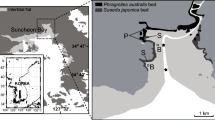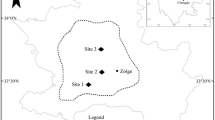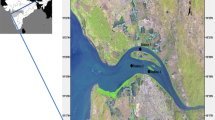Abstract
Ephemeral ponds are vulnerable aquatic habitats which are difficult to protect given their dynamic nature and sensitivity to degradation during dry periods. Little information is available on these habitats in austral regions, with almost no information on food-web structure and complexity. The study aimed to assess trophic interactions among dominant organisms in an ephemeral pond food web, and investigate the importance of autochthonous and allochthonous carbon, using 13C and 15N isotopes. Results of the investigation suggest that the food web comprised four trophic levels, with the top predators being Notonectids (Notonecta sp.) and diving beetles (Cybister tripunctatus (Olivier)). Intermediary trophic levels comprised zooplankton (daphniids and copepodids), macroinvertebrates (e.g. micronectids and molluscs) and tadpoles. Generalist feeders dominated the higher trophic levels (>3) with specialists comprising the lower trophic levels (≤3). The consumers preferred autochthonous fine particulate organic matter, epiphyton and submerged macrophyte organic matter sources over allochthonous sources. Autochthonous organic matter was transferred to the food web via zooplankton and select macroinvertebrates including Micronecta sp. and Physa sp. The food-web structure within the pond appeared to reflect the secondary stage of trophic structural complexity in the evolution of ephemeral ponds over the course of their hydro-period.



Similar content being viewed by others
References
Abrantes, K. G., A. Barnett & S. Bouillon, 2014. Stable isotope-based community metrics as a tool to identify patterns in food web structure in east African estuaries. Functional Ecology 28: 270–282.
Allanson, B. R., R. C. Hart, J. H. O’Keeffe & R. D. Robarts, 1990. Planktonic and benthic invertebrates. In Allanson, B. R. (ed.), Inland Waters of Southern Africa: An Ecological Perspective. Springer, Dordrecht.
Alp, M., B. L. Peckarsky, S. M. Bernasconi & C. T. Robinson, 2013. Shifts in isotopic signatures of animals with complex life-cycles can complicate conclusions on cross-boundary trophic links. Aquatic Science 75: 595–606.
APHA, 1995. Standard Methods for the Examination of Water and Wastewater. Port City Press, Baltimore.
Arcagni, M., L. M. Campbell, M. A. Arribére, K. Kyser, K. Klassen, R. Casaux, M. L. Miserendino & S. G. Guevara, 2013. Food web structure in a double-basin ultra-oligotrophic lake in Northwest Patagonia, Argentina, using carbon and nitrogen stable isotopes. Limnologica 43: 131–142.
Arnér, M., S. Koivisto, J. Norberg & N. Kautsky, 1998. Trophic interactions in rockpool food webs: regualtion of zooplankton and phytoplankton by Notonecta and Daphnia. Freshwater Biology 39: 79–90.
Arnott, S. E. & M. J. Vanni, 1993. Zooplankton assemblages in fishless bog lakes: influence of biotic and abiotic factors. Ecology 74: 2361–2380.
Baiser, B., R. S. Ardeshiri & A. M. Ellison, 2011. Species richness and trophic diversity increase decomposition in a co-evolved food web. PLoS ONE 6: e20672.
Bergamino, L., T. Dalu, A. K. Whitfield, L. Carassou & N. B. Richoux, 2014. Stable isotope evidence of food web connectivity by a top predator (Argyrosomus japonicus: Sciaenidae: Teleostei) in the Kowie Estuary, South Africa. African Journal of Marine Science 36: 207–213.
Blaustein, L., 1998. Influence of the predatory backswimmer, Notonecta maculata, on invertebrate community structure. Ecological Entomology 23: 246–252.
Blaustein, L. & S. S. Schwartz, 2001. Why study ecology in temporary pools? Israel Journal of Zoology 47: 303–312.
Brendonck, L. & L. De Meester, 2003. Egg banks in freshwater zooplankton: evolutionary and ecological archives in the sediment. Hydrobiologia 491: 65–84.
Brönmark, C. & L.-A. Hansson, 2005. The Biology of Lakes and Ponds (Biology of Habitats), 2nd ed. Oxford University Press, Oxford.
Carpenter, S. R., J. J. Cole, M. L. Pace, M. V. De Bogert, D. L. Bade, D. Bastviken, C. M. Gille, J. R. Hodgson, J. F. Kitchell & E. S. Kritzberg, 2005. Ecosystem subsidies: terrestrial support of aquatic food webs from 13C addition to contrasting lakes. Ecology 86: 2737–2750.
De Meester, L., S. Declerck, R. Stoks, G. Louette, F. van de Meutter, T. de Brie, E. Michaels & L. Brendonck, 2005. Ponds and pools as ecological model systems in conservation biology, ecology and evolutionary biology. Aquatic Conservation and Freshwater Ecosystems 15: 715–725.
Dillon, R. T., 2000. The Ecology of Freshwater Mollusks. Cambridge University Press, New York.
du Preez, L. H. & V. C. Carruthers, 2009. A Complete Guide to the Frogs of Southern Africa. Struik Nature, Cape Town.
Fernando, C. H. & C. Y. Leong, 1963. Miscellaneous notes on the biology of Malayan Corixidae (Hemiptera: Heteroptera) and a study of the life histories of two species, Micronecta quadristrigata Bredd. and Agraptocorixa hyalinipennis (F.). Journal of Natural History 6: 545–558.
Ferreira, M., V. Wepener & J. H. J. van Vuren, 2012. Aquatic invertebrate communities of perennial pans in Mpumalanga, South Africa: a diversity and functional approach. African Invertebrates 53: 751–768.
Francis, T. B., D. E. Schindler, G. W. Holtgrieve, E. R. Larson, M. D. Scheuerell, B. X. Semmens & E. J. Ward, 2011. Habitat structure determines resource use by zooplankton in temperate lakes. Ecology Letters 14: 364–372.
Froneman, P. W., 2002. Food web structure in three contrasting estuaries determined using stable isotope (δ13C) analysis. African Journal of Aquatic Sciences 27: 107–115.
Fry, B., 1991. Stable isotope diagrams of freshwater food webs. Ecology 72: 2293–2297.
Fry, B., 2006. Stable isotope ecology. Springer, New York.
Gamble, D. & J. J. Mitsch, 2009. Hydro-periods of created and natural vernal pools in central Ohio: a comparison of depth and duration of inundation. Wetlands Ecology and Management 17: 385–395.
Gebo, N. A. & R. P. Brooks, 2012. Hygreomorphic (HGM) assessments of mitigation sites compared to natural reference wetlands in Pennsylvania. Wetlands 32: 321–331.
Gerber, A. & M. J. M. Gabriel, 2002. Aquatic Invertebrates of South African Rivers: Field Guide. Institute for Water Quality Studies, Pretoria.
Giller, P. S., 1986. The natural diet of the Notonectidae: field trials using electrophoresis. Ecological Entomology 11: 163–172.
Harding, W. R. & R. C. Hart, 2013. Food-web structure in the hypertrophic Rietvlei Dam based on stable isotope analysis: specific and general implications for reservoir biomanipulation. Water SA 39: 615–626.
Hecky, R. E. & R. H. Hesslein, 1995. Contributions of benthic algae to lake food webs as revealed by stable isotope analysis. Journal of the North American Benthological Society 14: 631–653.
Heyer, W. R., R. W. McDiarmid & D. L. Weigman, 1975. Tadpoles, predation and pond habitats in the tropics. Biotropica 7: 100–111.
Hill, J. M., R. W. Jones, M. P. Hill & O. L. F. Weyl, 2015. Comparisons of isotopic niche widths of some invasive and indigenous fauna in a South African river. Freshwater Biology 60: 893–902.
Huang, I.-Y., Y.-S. Lin, C.-P. Chen & H.-L. Hsieh, 2007. Food web structure of a subtropical headwater stream. Marine and Freshwater Research 58: 596–607.
Jackson, A. L., R. Inger, A. C. Parnell & S. Bearshop, 2011. Comparing isotopic niche widths among and within communities: SIBER − stable isotope Bayesian ellipses in R. Journal of Animal Ecology 80: 595–602.
Klecka, J., 2014. The role of a water bug, Sigara striata, in freshwater food webs. PeerJ 2: e389.
Kopprio, G. A., G. Kattner, R. H. Freije, S. J. de Paggi & R. J. Lara, 2014. Seasonal baseline of nutrients and stable isotopes in a saline lake of Argentina: biogeochemical processes and river runoff effects. Environmental Monitoring and Assessment 186: 3139–3148.
Layman, C. A., J. P. Quattrochi, C. M. Peyer & J. E. Allgeier, 2007. Niche width collapse in a resilient top predator following ecosystem fragmentation. Ecology Letters 10: 937–944.
Lencioni, V., 2004. Survival strategies of freshwater insects in cold environments. Journal of Limnology 63: 45–55.
Mao, Z., X. Gu, Q. Zeng, L. Zhou & M. Sun, 2012. Food web structure of a shallow eutrophic lake (Lake Taihu, China) assessed by stable isotope analysis. Hydrobiologia 683: 173–183.
Marcus, V. & S. C. Weeks, 1997. The effects of pond duration on the life history traits of an ephemeral pond crustacean, Eulimnadia texana. Hydrobiologia 359: 213–221.
Mazunder, A., 1994. Patterns of algal biomass in dominant odd- versus even-link lake ecosystems. Ecology 75: 1141–1149.
McCutchan Jr, J. H., W. M. Lewis Jr, C. Kendall & C. C. McGrath, 2003. Variation in trophic shift for stable isotope ratios of carbon, nitrogen, and sulfur. Oikos 102: 378–390.
Measey, G. J., 1998. Diet of feral Xenopus laevis (Daudin) in South Wales, U.K. Journal of Zoology 246: 287–298.
Ohba, S., 2009. Feeding habits of the diving beetle larvae, Cybister brevis Aubé (Coleoptera: Dytiscidae) in Japanese wetlands. Applied Entomology and Zoology 44: 447–453.
O’Neil, B. J. & J. H. Thorp, 2014. Untangling food-web structure in an ephemeral ecosystem. Freshwater Biology 59: 1462–1473.
O’Reilly, C. M., R. E. Hecky, A. S. Cohen & P.-D. Plisnier, 2002. Interpreting stable isotopes in food webs: recognizing the role of time averaging at different trophic levels. Limnology and Oceanography 47: 306–309.
Pace, M. L., J. J. Cole, S. R. Carpenter & J. F. Kitchell, 1999. Trophic cascades revealed in diverse ecosystems. Trends in Ecology and Evolution 14: 483–488.
Palik, B. D., P. Baxter & C. Kern, 2006. Upland forest linkages to seasonal wetlands: litter flux, processing and food quality. Ecosystems 9: 142–151.
Parnell, A. C., R. Inger, S. Bearhop & A. L. Jackson, 2010. Source partitioning using stable isotopes: coping with too much variation. PLOS one 5: e9672.
Phillips, D. L., S. D. Newsome & J. W. Gregg, 2005. Combining sources in stable isotope mixing models: alternative methods. Oecologia 144: 520–527.
Phillips, D. L., R. Inger, B. Stuart, A. L. Jackson, J. W. Moore, A. C. Parnell & B. X. Semmens, 2014. Best practices for use of stable isotope mixing models in food-web studies. Canadian Journal of Zoology 92: 823–835.
Pinceel, T., B. Vanschoenwinkel & L. Brendonck, 2013. Flexible dispersal dimorphism in zooplankton resting eggs: an example of repeated phenotypic coin flipping? Biological Journal of the Linnean Society 110: 749–756.
Pinder, L. C. V., 1986. Biology of freshwater chironomidae. Annual Review of Entomology 31: 1–23.
Pinnegar, J. K. & N. V. C. Polunin, 1999. Differential fractionation of δ13C and δ15N among fish tissues: implications for the study of trophic interactions. Functional Ecology 13: 225–231.
Polačik, M., R. Blažek, R. Řežucha, M. Vrtílek, E. Terzibasi Tozzini & M. Reichard, 2014. Alternative intrapopulation life-history strategies and their trade-offs in an African annual fish. Journal of Evolutionary Biology 27: 854–865.
Post, D. M., 2002. Using stable isotopes to estimate trophic position: models, methods, and assumptions. Ecology 83: 703–718.
Proctor, H. & G. Pritchard, 1989. Neglected predators: water mites (Acari: Parasitengona: Hydrachnellae) in freshwater communities. Journal of the North American Benthological Society 8: 100–111.
Riato, L., C. van Ginkel & J. C. Taylor, 2014. Zooplankton and diatoms of temporary and permanent freshwater pans in the Mpumalanga Highveld region, South Africa. African Zoology 49: 113–127.
Sinchembe, M. & W. N. Ellery, 2010. Human impacts on hydrological health and the provision of ecosystem services: a case study of the eMthonjeni–Fairview Spring Wetland, Grahamstown, South Africa. African Journal of Aquatic Science 35: 227–239.
SPSS Inc. 2007. SPSS Release 16.0.0 for Windows. Polar Engineering and Consulting. Chicago, SPSS Inc.
Suárez-Morales, E., R. J. Wasserman & T. Dalu, 2015. A new species of Lovenula Schmeil (Copepoda, Diaptomidae) from the Eastern Cape province of South Africa. Crustaceana 88: 324–342.
Vanni, M. J., 1986. Competition in zooplankton communities: suppression of small species by Daphnia pulex. Limnology and Oceanography 31: 1039–1056.
Vanni, M. J., 1988. Freshwater zooplankton community structure: introduction of large invertebrate predators and large herbivores to a small species community. Canadian Journal of Fisheries and Aquatic Sciences 45: 1758–1770.
Vareschi, E. & J. Jacobs, 1985. The ecology of Lake Nakuru. Oecologia 65: 412–424.
Yachi, S. & M. Loreau, 1999. Biodiversity and ecosystem productivity in a fluctuating environment: the inárance hypothesis. Proceeding of the National Academy of Science 96: 1463–1468.
Yang, C., G. M. Wilkinson, J. J. Cole, S. A. Macko & M. L. Pace, 2014. Assigning hydrogen, carbon, and nitrogen isotope values for phytoplankton and terrestrial detritus in aquatic food web studies. Inland Waters 4: 233–242.
Zacharias, I., E. Dimitriou, A. Dekker & E. Dorsman, 2007. Overview of temporary ponds in the Mediterranean region: Threats, management and conservation issues. Journal of Environmental Biology 28: 1–9.
Acknowledgments
This paper is dedicated to the memory of Sven Kaehler who carried out the stable isotope analysis. This study was made possible through financial and logistical support from Rhodes University and the National Research Foundation (NRF) of South Africa (UID: 77444). We thank PSR Weyl and T Bellingan (Department of Zoology and Entomology, Rhodes University) for assistance with macrophyte and macroinvertebrate identification, respectively, and Eduardo Suárez-Morales of El Colegio La Frontera Sur (ECOSUR), Mexico for copepod identification. In addition, we extend our gratitude to the White family for granting us access to their property. We thank the handling editor Mariana Meerhoff for her patience and two anonymous reviewers for their work and time through providing insightful and useful comments on the manuscript.
Author information
Authors and Affiliations
Corresponding author
Additional information
Handling editor: Mariana Meerhoff
Electronic supplementary material
Below is the link to the electronic supplementary material.
Rights and permissions
About this article
Cite this article
Dalu, T., Weyl, O.L.F., Froneman, P.W. et al. Trophic interactions in an austral temperate ephemeral pond inferred using stable isotope analysis. Hydrobiologia 768, 81–94 (2016). https://doi.org/10.1007/s10750-015-2533-5
Received:
Revised:
Accepted:
Published:
Issue Date:
DOI: https://doi.org/10.1007/s10750-015-2533-5




